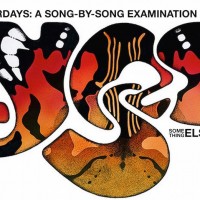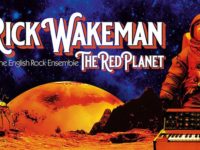Dan Wooding, author of 45 books, was the first journalist to ever write a story about the young Rick Wakeman. That gives him a unique perspective on the legendary keyboardist’s work with prog-rock pioneers Yes, but also his interesting solo work and sideman projects over the years.
Wooding’s new 2012 authorized biography on Wakeman, called Caped Crusader takes us inside the early Yes years, as Wakeman assumes the keyboard chair for founding member Tony Kaye. But there’s much more to Wooding’s tale.
Wakeman left Yes in the middle part of the decade, producing a trio intriguing individual albums called The Six Wives of Henry VIII, Journey to the Centre of the Earth, and The Myths and Legends of King Arthur and the Knights of the Round Table, all between 1973-75, before returning for what would be a series of reunions with Yes. (Wakeman was also a member of the band from 1976-80, part of the splinter group Anderson Bruford Wakeman Howe beginning in 1989 and then in Yes again until 1992, followed by two more stops in 1995-97 and 2002-04.)
Along the way, there are a number of fascinating side roads, including an early moment when Wakeman was faced with joining Yes or participating in the initial lineup of David Bowie’s seminal band the Spiders from Mars.
In this interesting excerpt, Wooding takes us into the studio through the eyes of the late producer Gus Dudgeon, who oversaw the 1969 sessions for Bowie’s breakout single “Space Oddity.” Wakeman, then an unknown, had been invited to add a Mellotron part of the song, but showed up late — after most of the mixing had already been completed. Wakeman proceeded to compose the song’s memorable keyboard signature on the spot, and to perform it in a brilliant first take.
Originally published in 1978, Caped Crusader: Rick Wakeman in the 1970s, has been updated and reissued for 2012 by the Gonzo Media Group, with a forward by Elton John. The following except is published with permission from the publisher …
Gus Dudgeon, who has since produced Elton John’s big hits, (and who sadly died in 2002) recalls: “Tony Visconti and I were then working in the same suite of offices.In those days, you couldn’t give Bowie away. The only record company that would take him was Mercury, in America. I knew Bowie from the days when I was an engineer at Decca and I did all the engineering on the two albums that he did for them.
“One day Tony called me over the internal phone and said, ‘I know this sounds bizarre, Gus, but I’ve been working with David, and Mercury say he must record ‘Space Oddity’ as a single because the first American moon shot is coming up. I want to do the album with him but I can’t stand this song. Would you be interested?”
“I listened to the demo and thought it was unbelievable. I couldn’t believe Tony didn’t want it, and so I called him up and said I’d do it. This was in the early days of Mellotrons. I think The Beatles’ Abbey Road had come out by then and they had used it a lot on that album. So as Bowie and I were discussing, it we came up with the idea of a Mellotron, not to be used as a string section, but as its typical sound — very doleful and mournful. We decided that was fine, but there weren’t many people who knew how to get a decent sound out of the instrument. So we got the whole thing planned down to the smallest detail, because I knew “Space Oddity” had a chance of being a hit. We planned where the Mellotron would come in and out, but because we knew so little we couldn’t really write a part for it.
“So then we went back to Tony’s office, told him what we were going to do, and asked him if he knew anybody who could play a Mellotron. He said, ‘I only know one bloke, called Wakeman, but he plays in a dance band.’ I said sarcastically, ‘That sounds great.” And he said, “He’s all right. I’ve been using him on Juniors Eyes’ sessions.’ So I said, ‘Well, it’s a gamble but let’s give it a whirl. If it’s a disaster we’ll over-dub it again.’
“So we went into Trident Studios, London, and started running it through. But there was no sign of our Mellotron player. I thought, ‘This is great!’ We got to the point where we had the whole thing down to a fine art and it really was sounding good. I was feeling very pleased with myself because it was the first time that I had really worked on a record, and something that had sounded a certain way in my head was beginning to sound correct in the studio.
“At the last minute, the door opened and this great long streak walked in and said, ‘I’m terribly sorry. My name’s Rick Wakeman — I’ve been booked to play Mellotron.’ So I said, ‘Well, this is a bit of an inopportune time to arrive. We’re on the point of laying a track down.’ He said, ‘Gosh, I’m terribly sorry.’ I told him, ‘The only thing I can do is mark on this chart the points where I would like you to play, and maybe while we lay this one down you can sit and listen to the thing as a whole and see what is required. I must be honest with you, I know very little about Mellotrons — I don’t know how to get a sound out of them or anything.’ Rick said, ‘Leave it to me.’
“So I went over to the box and did a take and Rick sat there looking at his part without playing a note. Barry, the engineer, looked at me and raised his eyebrows as if to say, ‘Who’s this freak?’ And I said, ‘I don’t know. Just some mad bloke that Visconti sent me.’ Anyway, we got to the end of the first take and decided to have a playback, and Rick came in and listened to it. I reminded him again of the places and he said, ‘It’s all right, I’ve worked it out. Are you going to do another take?’ I said we were. He asked, ‘Do you mind if I have a go on this one?’ I thought this was pretty ambitious but said, ‘All right.’
“Well, we did a run-through and got three-quarters of the way through and Rick came in the right place. And what he played was exactly what I wanted. It was incredible! We did one more take and it was a master. I thought, ‘This is weird.’ This strange bloke was all covered in spots and had greasy hair, wearing the most dreadful clothes. And we were all wearing Carnaby Street stuff.
“We sat down and listened to the playback and he said, ‘That’s all right, isn’t it?’ I said. ‘It sounds pretty good to me. I think we have a hit there.’ And Rick said. ‘Well, is that all you want?’ I said, ‘Yes, thanks very much.’ And off he went. Just like that, back to his ballroom job. I thought, ‘What a weird bloke!’ I really liked him. I thought he was great. But he was so weird!”
Rick told me, “I thought ‘Space Oddity’ was a guaranteed monster record. It came out around July 1970, and I played it to lots of people. Everybody said, ‘No, it’s not very good.’ I thought after a while they must have been right, because it did nothing at all. But around Christmas it suddenly came to life again, and did monstrously well.”




